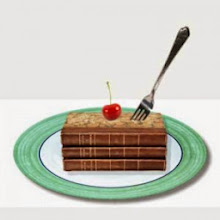 So this week is Banned Books week, in which librarians all over the country highlight books that have been banned or challenged, and celebrate our First-Amendment-given right to read whatever we want.
So this week is Banned Books week, in which librarians all over the country highlight books that have been banned or challenged, and celebrate our First-Amendment-given right to read whatever we want.While for librarians this is a fairly hot-button issue, sometimes I think the general public has a harder time understanding why it's a bad thing that certain books are objected to and possibly removed from library shelves. I had to explain BBW to a new employee yesterday, and the most efficient way I could think to put it was, "We believe that parents have the right to tell their own children what they can't read. They do not have the right to tell other people's children what they can't read."
Why does this matter on this blog? I read sweet little picture books. There's nothing to fear from sweet little picture books.
In fact, a couple of the most widely publicized book banning efforts have been against sweet little picture books. (And I've read them, and they are sweet.)
 First up is And Tango Makes Three by Justin Richardson and Peter Parnell, and illustrated by Henry Cole, about two male penguins who adopt a baby chick. All together now: awwww.
First up is And Tango Makes Three by Justin Richardson and Peter Parnell, and illustrated by Henry Cole, about two male penguins who adopt a baby chick. All together now: awwww.Unfortunately, this is the number-one challenged book of 2007. From the ALA Most Frequently Challenged Books of 2007
“And Tango Makes Three,” by Justin Richardson and Peter ParnellOkay, I have to say that I understand most of the charges. I don't agree with them, but I understand where they're coming from. But Anti-Ethnic? Can someone explain that one to me? I'm not being snarky (okay, a little) but really, I don't get it.
Reasons: Anti-Ethnic, Sexism, Homosexuality, Anti-Family, Religious Viewpoint, Unsuited to Age Group
 Second, a couple of the cutest picture books you'll ever see. Linda de Haan and Stern Nijland's Koning en Koning was translated from the Dutch and published in English as King and King. They followed that up with King and King and Family. As might expected, the first is a fairy tale with a twist--the wife-seeking prince finds a husband instead. In the second, the two kings adopt a princess of their very own.
Second, a couple of the cutest picture books you'll ever see. Linda de Haan and Stern Nijland's Koning en Koning was translated from the Dutch and published in English as King and King. They followed that up with King and King and Family. As might expected, the first is a fairy tale with a twist--the wife-seeking prince finds a husband instead. In the second, the two kings adopt a princess of their very own.In 2006, a couple of Massachusetts parents objected to this book being used as part of a classroom lesson on marriage. The Wikipedia entry gives some details. One of the parents stated,
"We felt like seven years old is not appropriate to introduce homosexual themes." and "My problem is that this issue of romantic attraction between two men is being presented to my seven-year-old as wonderful, and good and the way things should be."It's no coincidence that both books were objected to on grounds of containing homosexuality. Talking with Lee Wind of I'm Here, I'm Queer, What the Hell Do I Read? this weekend, he pointed out that when some people think of homosexuality, they think of it this way: homoSEXuality. In other words, the mere fact that two kings or two male penguins are a couple means they will have to explain the gay birds and bees to a six-year-old. Yikes.
The judge dismissed the lawsuit, saying, "Diversity is a hallmark of our nation".
As a librarian, I see these books as being about different kinds of family, and two of them are about adoption. No sex, and for the savvy parent, there doesn't have to be.
Picture books and YA books (my two faves! Coincidence? Hmm) are in my opinion the two most vulnerable age groups of books. Picture books because parents read them to curious, question-asking children, and the parent who is caught unawares by a concept they're not ready to talk about is doubly defensive. I think the only reason we don't see more picture books on the banned books list is that picture books tend to be on the conservative side. Very few of them even feature single-parent or multiracial families, much less same-sex parenting. However, that's beginning to change as our society becomes more open and diverse.
Have you heard of other banned or challenged picture books? Let me know!





No comments:
Post a Comment